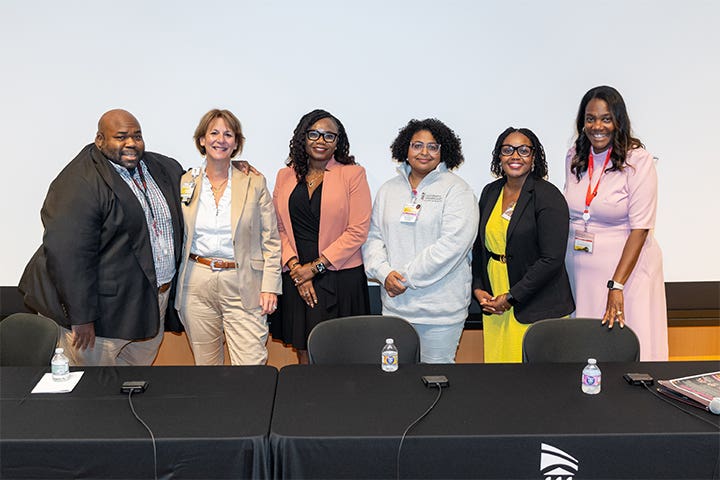Nurses of color face significant barriers to success in the profession, from implicit bias to outright racism, and the lack of diversity in the profession harms patients. These themes are central to the documentary film “Everybody’s Work: Healing What Hurts Us All.”
The film was directed by Chad Tingle and produced by SHIFT films, with support from the Robert Wood Johnson Foundation. The University of Maryland School of Nursing (UMSON) in Baltimore hosted a screening and panel discussion on the film on Tuesday.
Gatekeeping, an Open Secret
For decades, Black nurses were barred from entering many nursing programs, so they created their own, Katie Boston-Leary, PhD, RN, director of nursing programs for the American Nurses Association (ANA) and a participant in the film, told MedPage Today in a phone call.
As a nursing student, Boston-Leary was set on becoming an operating room nurse but when she asked her professor to sign a form allowing her to apply for an internship in perioperative nursing, she was told, “I just don’t see you doing this.”
Years later, she recognized her professor’s words for what they were: gatekeeping. The more acute a hospital unit is, the less diverse it is, she said.
“Even after they see your potential … there’s still this overwhelming thinking … that nurses of color are less educated … and that certain profiles and certain people are supposed to be in certain spaces and others are kept out,” Boston-Leary said.
Envisioning a Future in Nursing
Yvette Conyers, DNP, RN, associate dean for equity, diversity, and inclusion at UMSON, who moderated the panel discussion after the screening, remembered her high school counselor’s response when she spoke about becoming a nurse. “Nursing isn’t for you,” Conyers recalled the counselor saying, suggesting she pursue a secretarial role instead.
It was her home economics teacher, a white woman, who encouraged her dream. “She gave me hope back,” Conyers told MedPage Today. Even after Conyers became a mother at 17, that teacher still believed she could do it, she said.
Anna Maria Valdez, PhD, RN, chair of nursing at Sonoma State University in northern California, who appears in the documentary, said she was also a teen mom.
After seeing an advertisement, Valdez reached out to a recruiter about getting her associate’s degree. The recruiter quickly steered her towards a bachelor of science in nursing (BSN) program, saying she was an “excellent” candidate. Valdez said her mother was Black and her father was white, and she herself looks white. She believes her skin color is the primary reason she was encouraged to take a more challenging, financially rewarding career path.
The majority of nurses in associate’s degree programs are people of color, but many large institutions prefer BSN students.
However, Tingle, the film’s director, told MedPage Today that despite accounting for a smaller subset of the nursing profession, Black nurses pursue advanced degrees at higher rates because “it’s really the only way to move up.”
Climbing the Career Ladder
Another documentary participant, Tonja Copeland, MSN, RN, a licensed vocational nurse (LVN) at UC Davis Health in Sacramento, California, said she grew up poor and didn’t have many role models. She was inspired by the nurses who cared for her ill sister to become a nurse.
“It was heart-moving. It just made me want to be like them,” she said.
Over 23 years, Copeland, who earned an LVN certificate, applied a dozen or more times to nursing schools. Then, incredibly, over a 4-year period beginning in 2019, she completed two associate’s degrees, her bachelor’s degree, and a master’s degree.
Boston-Leary said many licensed practical nurses and LVNs stay in their roles because RN programs often expect students not to work or at least not full-time. Those who can’t afford not to work end up working nights, and come to classes and clinicals tired, are seen as disengaged, and are quickly weeded out of programs, she explained.
A “two strikes you’re out” policy — highlighted in the film — is also standard in many RN programs, she added, pointing out that some schools view it as a badge of honor — a sign that “we want the best of the best.”
Meanwhile, the healthcare system is teeming with people who have stories to tell about how they tried going to nursing school and didn’t make it, she said.
Conyers noted that getting even one strike is demoralizing. After failing her ob/gyn class in her second year of nursing school, she said she was forced into a different cohort where she felt isolated and depressed.
Pointing to progress, she said that UMSON has begun to discuss a “holistic admissions” concept that assesses not only math and science skills, but also attributes like “grit” and the “ability to get through tough times.”
Tingle agreed that something has to change. People should only be granted positions they deserve, but sometimes students are made to feel “othered,” and “people who don’t fit comfortably into an environment can’t thrive,” he said.

(L to R) Hershaw Davis Jr., DNP, MBA, RN, assistant professor, UMSON; Karen Doyle, DNP, MBA, RN, NEA-BC, FAAN, senior vice president of patient care services and chief nursing officer, University of Maryland Medical Center; Katie Boston-Leary, PhD, MBA, MHA, RN, director of nursing programs for the American Nurses Association; Mona Rai, MPH, Bachelor of Science in Nursing student, UMSON; Yvette Conyers, DNP, RN, associate dean for equity diversity and inclusion at UMSON; Yolanda Ogbolu, PhD, NNP, FNAP, FAAN, and the Bill and Joanne Conway Dean of the University of Maryland School of Nursing
Why Diversity Matters
Theresa Pak, RN, NEA, inpatient unit director and nurse manager for UC Davis Health, who appears in the documentary, recalled the story of a Mexican immigrant who had a kidney transplant. When a white nurse readied him for discharge and asked how he was, he said he was fine. When a Spanish-speaking nurse visited and spoke to him in his language, he shared a laundry list of concerns.
A 2019 review in the Journal of the National Medical Association found that diversity improves patient care quality, and a 1999 study in JAMA Internal Medicine found that when Black patients were treated by Black physicians, they were more likely to agree to recommended care.
Valdez noted that when her mother was in the hospital, she called the nurse on duty to ask why she sounded disoriented and confused over the phone. The nurse, unfazed, replied that people sometimes bring in drugs from home. Valdez, who knew her mother was not on any drugs, pressed the nurse to call a rapid response. She later discovered her mother had been given her roommate’s medication.
Since then, Valdez said that she never lets her mother or any other Black relative go to the hospital without her.
Breaking Down Barriers, Building Allies
Asked what steps can be taken to promote a more equitable environment in nursing, Hershaw Davis Jr., DNP, RN, an assistant professor at UMSON, stressed the need for representation.
Davis chose to become a professor because he wanted other young Black men to see what was possible. Paraphrasing the civil rights activist Marian Wright Edelman, he added, “we can’t become what we can’t see.”
Karen Doyle, DNP, RN, senior vice president of patient care services and chief nursing officer for the University of Maryland Medical Center in Baltimore, added that her focus is to ensure that the team looks like the patients and families she serves.
Boston-Leary said the profession should focus on developing a “system of allies.” She pointed to a 2022 ANA survey, which found that 92% of Black nurses feel there is racism in nursing, but only 29% of white nurses agree.
“The only way to bridge those two lenses is for there to be allyship,” she said.



![author['full_name']](https://neojimcrow.art/wp-content/uploads/2024/09/shannonFirth_188.jpg)